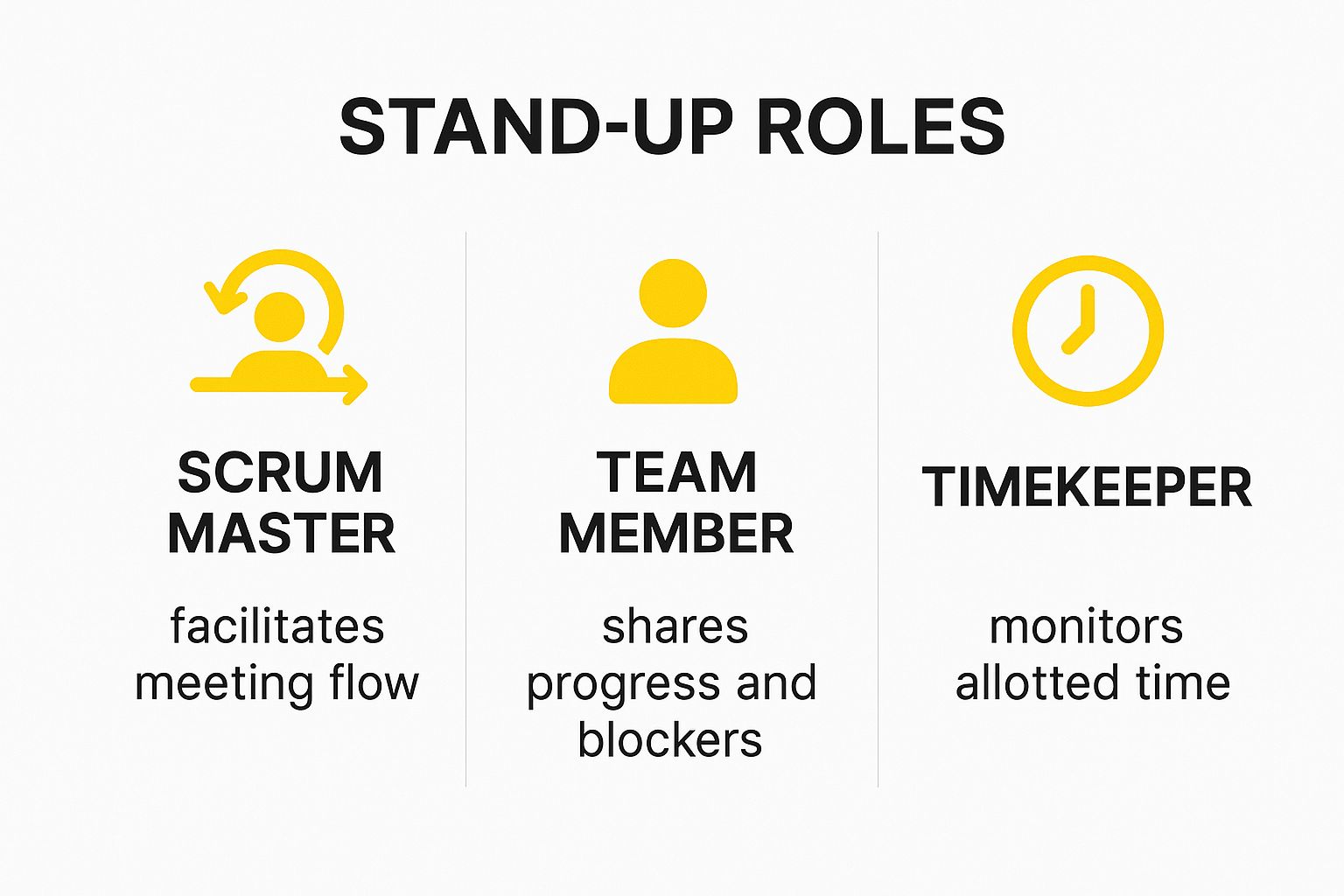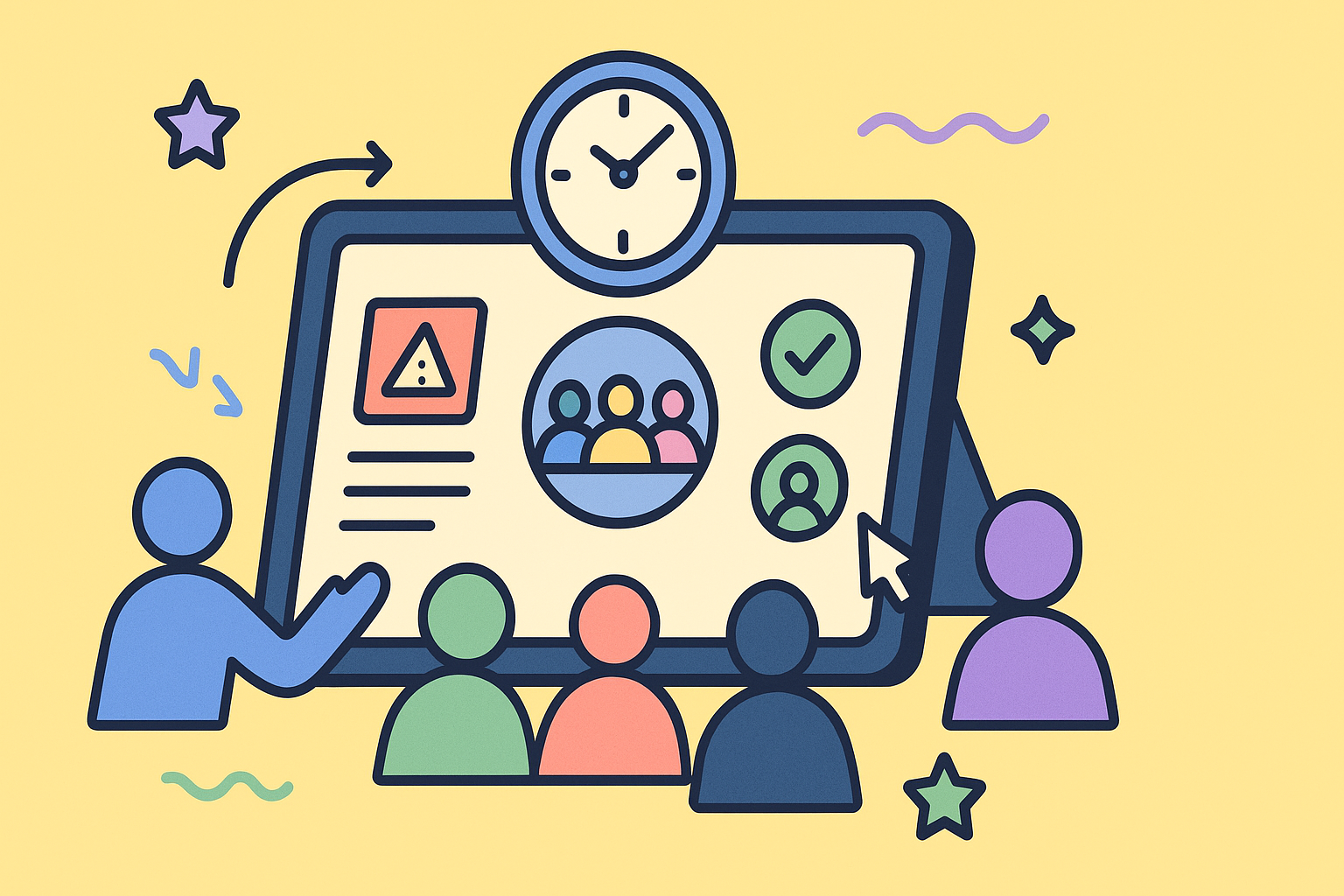A great stand-up meeting agenda is what keeps your daily huddle focused and, most importantly, under 15 minutes. It’s the tool that elevates the meeting from a robotic status update to a strategic sync, actively identifying blockers and aligning the team on what truly matters today.
Why Your Daily Stand-Up Feels Like a Chore

Let’s be honest. Does your daily stand-up feel more like a daily hurdle? If you’re nodding your head, you’re not alone. So many teams dread this meeting because it drags on, lacks any real focus, and leaves everyone feeling more confused than aligned. This almost always comes down to a broken or nonexistent stand-up meeting agenda.
The classic “three questions”—what I did, what I’ll do, what’s blocking me—is a great starting point, but it can quickly become a monotonous reporting session. People go on autopilot, listing off tasks without connecting them to the bigger picture. The result? A meeting that feels like a status report for the manager, not a collaborative sync-up for the team doing the work.
The Warning Signs of a Failing Stand-Up
You can tell when a stand-up is on life support. Are team members staring at their second monitor or glancing at their phones? That’s a classic sign of disengagement. Does the conversation constantly get sidetracked into a deep-dive problem-solving session between just two people, while everyone else awkwardly waits? That’s another huge red flag.
When the agenda is weak, meetings lose their purpose and bleed valuable time. This isn’t just an annoyance; it has a real financial impact. Executives estimate that a staggering 67% of meetings are considered ineffective. This problem has only gotten worse, with remote teams seeing a 70% increase in virtual meetings since the pandemic began.
A great agenda is more than a checklist; it’s a strategic tool. It fosters genuine communication, drives accountability, and builds a culture of proactive problem-solving.
Recognizing these symptoms is the first step. The table below breaks down some common issues you might be seeing and what’s likely causing them.
Signs of a Failing Stand Up Meeting
| Symptom | Potential Cause | Impact on Team |
|---|---|---|
| Meeting consistently runs over 15 minutes. | No timekeeper or a weak, unfocused agenda. | Meeting fatigue, loss of focus, and resentment. |
| Updates are vague and lack detail. | Team members are unprepared or the format is too rigid. | Misalignment on progress and missed collaboration opportunities. |
| The meeting feels like a status report to the manager. | The focus is on individual tasks, not collective goals. | Low engagement, lack of ownership, and a passive team dynamic. |
| Blockers are mentioned but never resolved. | No clear process for assigning ownership to impediments. | Frustration, stalled progress, and decreased morale. |
| Team members seem disengaged or distracted. | The meeting provides no real value to them. | Wasted time and a breakdown in team communication. |
Seeing your team’s struggles in this table can be a lightbulb moment. These aren’t just minor frustrations; they’re indicators of a deeper issue with how your team synchronizes.
From Status Report to Strategic Huddle
The core problem is when a stand-up becomes a backward-looking report instead of a forward-looking planning session. The point isn’t just to hear a list of what people did. It’s to understand how that work moves the needle on the sprint goal and to clear any obstacles standing in the way of tomorrow’s progress.
Without a strong agenda, the meeting defaults to being about individual activity, not collective achievement. A truly effective agenda shifts this focus by:
- Centering on goals: The conversation should revolve around progress toward the sprint goal, not just a random list of completed JIRA tickets.
- Prioritizing blockers: The most important part of the stand-up is identifying impediments and figuring out who can help remove them.
- Keeping it concise: A tight structure respects everyone’s time and keeps the energy high.
Fixing these issues isn’t hard, but it does require a deliberate change. By learning how to run effective daily stand-up meetings, you can transform this daily ritual from a dreaded chore into an indispensable tool that energizes your team for the day ahead.
Building an Agenda That Actually Drives Progress

Let’s be honest: most stand-up agendas are boring. They’re a robotic march through individual reports that suck the energy out of the room. To build an agenda that actually moves the needle, you have to think beyond that stale format.
A powerful stand up meeting agenda isn’t a checklist; it’s a framework for a real, forward-looking conversation. The goal is to create a quick touchpoint that energizes the team for the day ahead, not one that leaves them drained and wondering why they just wasted 15 minutes. This small shift from “what I did” to “how we’re progressing” is subtle, but it makes all the difference.
A well-oiled agenda is also one of the best tools for keeping your team aligned and locked in. For anyone trying to level up their team’s output, it’s worth exploring other strategies for ultimate focus and productivity that complement a great stand-up.
Start With a Quick Team Health Check
Before jumping into tasks and goals, take just 60 seconds for a human-to-human connection. It sounds small, but it’s a game-changer. A simple round-robin asking for a one-word check-in or a quick “green/yellow/red” status can tell you a lot.
This isn’t therapy. It’s a rapid pulse check. If someone says they’re “yellow” or “feeling distracted,” the team lead now has crucial context for the rest of the day—without derailing the entire meeting. This simple act builds psychological safety and acknowledges that your team is made up of people, not just resources.
Center the Conversation on Sprint Goals
Instead of the classic, “What did you do yesterday?” let’s reframe the entire conversation around collective goals. This one change flips the script from individual to-do lists to shared outcomes.
Here’s a structure that works much better:
- Progress Toward Goals: “What did we accomplish yesterday that moved us closer to our sprint goal?” This forces everyone to connect their daily grind to the bigger picture.
- Plan for Today: “What’s our plan today to make the biggest dent in our goal?” This immediately gets the team thinking strategically about the next 24 hours.
This goal-first approach keeps everyone locked on the mission. It’s also incredibly motivating when people see exactly how their piece of the puzzle contributes to the team’s success. If you’re looking for a solid starting point, a Scrum daily standup meeting template can help you structure this effectively.
The core purpose of a stand-up is to facilitate the team’s success for the next 24 hours. The agenda should be a tool that serves this purpose, focusing on alignment and obstacle removal above all else.
Make Blockers Actionable
This is where most stand-ups fall apart. A blocker that’s mentioned without an owner is just a complaint hanging in the air. The final part of your meeting must be dedicated to turning these roadblocks into action.
As soon as a blocker is raised, the facilitator should immediately ask two direct questions:
- Who can help resolve this? This gets the whole team engaged in problem-solving on the spot.
- What is the very first step, and who owns it? This assigns clear accountability and creates a tangible action item.
Stand-ups in an Agile setting are meant to be fast—15 minutes or less—to keep the momentum high. While they’re all about progress and blockers, their role in team cohesion is just as vital, especially when you consider that 89% of professionals attend team meetings every week. By assigning clear ownership to blockers, you ensure they get tackled immediately instead of just being noted down for later.
Adapting Your Agenda For Remote And Hybrid Teams

The shift to remote and hybrid work has completely changed the game for the daily stand-up. That spontaneous energy you get from an in-person huddle just doesn’t magically appear through a screen. It’s easy for virtual stand-ups to become disjointed, with people talking over each other or, even worse, just tuning out entirely.
To make it work, a remote stand up meeting agenda needs to be deliberate about recreating that feeling of presence and focus. This means really leaning into your digital tools and tweaking your communication style for a virtual-first world.
Fostering Connection Across Screens
Let’s be honest: the biggest challenge is the loss of non-verbal cues. You miss the subtle nods, the raised eyebrows, the little things that tell you someone is engaged or confused. To fight this, you have to set some clear ground rules for engagement.
- Cameras On, When Possible: This isn’t about surveillance; it’s about connection. Seeing faces helps build trust and keeps everyone locked in. It turns a series of disconnected reports into a real conversation.
- Use Virtual Hand-Raising: It might feel a bit like school, but this simple feature in tools like Zoom or Teams is a lifesaver. It stops interruptions and ensures the conversation flows smoothly without turning into a free-for-all.
- Lean on Visual Aids: Don’t just talk—show. Share your screen and walk the team through a digital Kanban board in Trello or a brainstorming session on a Miro board. Having a visual anchor keeps everyone on the same page and gives the meeting a focal point.
Making these small adjustments is a huge part of managing remote teams effectively. They help preserve the collaborative spirit that makes stand-ups so valuable in the first place.
Bridging Time Zones With a Hybrid Approach
What happens when your team is scattered across the globe? A single live meeting just isn’t going to work for everyone. The trick is to blend your synchronous (live) and asynchronous (written) communication.
Imagine a team split between London and San Francisco. Finding a time that isn’t painfully early for one or ridiculously late for the other is nearly impossible. Instead of forcing it, try a hybrid model. The live stand-up can happen at a time that works for the European folks. Meanwhile, the US-based members can post their updates beforehand in a dedicated Slack channel. The meeting facilitator then simply reads those updates out loud during the live call.
This approach makes sure everyone is included without wrecking their work-life balance. This kind of flexibility has become the new standard. In fact, from 2020 to 2022, the share of virtual meetings jumped from 48% to 77% of all meetings worldwide. Zoom alone saw its daily participants skyrocket by 2900%. You can check out more stats on the rise of virtual meetings on Notta.ai.
A remote stand-up doesn’t have to be a lesser version of its in-person counterpart. By thoughtfully using technology, you can create a highly focused and inclusive daily sync that works for everyone, regardless of their location.
With an effective agenda, your live meeting time is spent on what truly matters: tackling blockers and solving problems together. The simple status updates can be handled asynchronously, respecting everyone’s time and making those live moments far more impactful.
So, your team has the basic stand-up down pat. That’s great! But once the fundamentals are solid, it’s time to start thinking beyond just the basics. We’re not just aiming for efficiency anymore; we’re looking to turn this daily huddle into a powerhouse for team growth, genuine ownership, and sharper strategic focus. Moving past the standard three questions keeps the meeting fresh and ensures it stays impactful.
A simple yet powerful shift is to start rotating the facilitator role. When the Scrum Master or team lead runs every single meeting, it can unintentionally create a dynamic where the team feels like they’re just reporting to a manager. By passing the facilitator hat around, every team member gets a turn to lead the conversation and develop a stronger sense of ownership over the meeting’s success.
Introduce Thematic Stand-Ups
To keep the daily check-in from getting stale, try injecting some weekly themes. This is a fantastic way to sharpen the team’s focus and encourage different ways of thinking beyond the day-to-day grind. You don’t have to do it every day, but dedicating one day a week to a specific topic can work wonders.
Here are a couple of ideas I’ve seen work really well:
- Tech Debt Tuesday: Set aside a few minutes to talk about any technical shortcuts the team has taken or cleanup tasks that are starting to pile up. This keeps technical debt visible and makes sure it doesn’t get ignored until it becomes a massive problem.
- Feedback Friday: Use this time to share a recent piece of customer feedback, whether it’s a rave review or a pointed criticism. Connecting the team’s daily work to its real-world impact is a huge motivator and keeps everyone grounded in the “why” behind their tasks.
This image really drives home how different roles come together to make a stand-up click.

It’s a great visualization of how distinct responsibilities—from facilitation and participation to timekeeping—interlock to create a meeting that’s both structured and genuinely productive.
Ground Your Discussion in Data
Instead of relying only on what people say, try anchoring your stand-up in cold, hard data. This brings an objective lens to the conversation and helps the team see progress—or the lack of it—in black and white.
A great way to start is by kicking off the meeting with a quick look at a key metric from your project management tool. The classic burndown chart is perfect for this, offering an instant snapshot of whether the team is on track to hit its sprint goal. Talking about the “why” behind the chart’s trajectory can uncover hidden blockers you didn’t know about or give the team a reason to celebrate their collective momentum.
For a deeper dive into how top-tier teams run their huddles, check out this fascinating stand-up guide for Scrum Masters inspired by NASA.
The goal of a stand-up isn’t just to talk about work; it’s to align on how to get work done more effectively. Using data and rotating facilitators ensures the meeting serves the team, not just the process.
To see how these advanced techniques change the meeting’s feel, let’s compare the old way with a more modern approach.
Traditional vs Enhanced Stand Up Agenda
| Agenda Item | Traditional Approach | Enhanced Approach |
|---|---|---|
| Opening | Scrum Master starts the meeting. | Rotating facilitator kicks things off. |
| Updates | Each person answers the 3 questions. | Updates are brief, tied to a visual board. |
| Focus | Individual status reporting. | Sprint goal progress and team-wide blockers. |
| Data | Updates are purely verbal. | Key metric (e.g., burndown chart) is reviewed. |
| Special Topics | N/A – often avoided to save time. | Weekly themes (e.g., Tech Debt) are included. |
| Closing | Meeting ends when the last person speaks. | Facilitator confirms next steps for blockers. |
This table shows a clear shift from a simple status report to a more strategic, data-informed alignment session. The enhanced approach fosters more ownership and a proactive, problem-solving mindset.
Master the Art of Staying Concise
As you start adding these new elements, you run the risk of letting the meeting drag on. Protecting that 15-minute timebox is absolutely non-negotiable.
There are two simple but incredibly effective techniques to maintain discipline.
First, use a visible timer. Projecting a big countdown clock on the screen creates a shared sense of urgency and naturally encourages everyone to get to the point.
Second, become a master of the “parking lot.” When a discussion starts diving too deep or only involves a couple of people, the facilitator needs to politely step in. A simple, “This is a great conversation, but it needs more time. Let’s put it in the parking lot and connect after stand-up with the right people,” works perfectly. It validates the topic’s importance without derailing the meeting for everyone else.
Common Stand-Up Mistakes and How to Fix Them
Even with a perfectly crafted stand-up meeting agenda, things can go sideways. I’ve seen it happen countless times: a focused huddle quickly devolves into a drawn-out problem-solving session or a monologue from a single team member.
Recognizing these common pitfalls is the first step, but having a game plan to correct them in the moment is what really counts. As a facilitator, your job isn’t just to kick off the meeting but to actively steer it, making sure it stays the high-energy, valuable touchpoint it’s meant to be.
The Meeting Becomes a Problem-Solving Session
This is probably the most frequent stand-up killer. Someone mentions a blocker, and suddenly, two or three well-intentioned teammates dive in, trying to debug the issue right then and there. While the spirit of helping is great, it sidelines everyone else and completely hijacks the meeting’s purpose.
The fix? The “parking lot” technique.
When a conversation starts spiraling into a deep-dive, you can politely interject. Try something like: “This is a critical discussion, but it feels like it needs more time than we have right now. Let’s add it to the parking lot and have Sarah, Mike, and Jen sync up right after stand-up to tackle it.” This approach validates the importance of the issue without sacrificing everyone else’s time.
One Person Dominates the Conversation
We all know the type. Every team seems to have one person whose update is less of a concise report and more of a long-winded story. This not only throws the schedule off track but can also make other people rush through their updates or feel hesitant to share at all.
Here are a few ways I’ve found to manage this:
- Set Clear Expectations: Remind everyone before the meeting that updates should be brief and focused on progress toward team goals. A simple “Let’s keep it quick and to the point today!” can work wonders.
- Use a Timer: A visible countdown timer for each person creates a natural, impartial boundary. It makes time feel tangible and encourages everyone to be more concise.
- Facilitate Proactively: If someone starts rambling, gently guide them back. A soft interruption like, “Thanks for that detail. For the sake of time, can you summarize your key blocker for the team?” usually does the trick.
The goal isn’t to be rigid but to maintain the meeting’s energy and focus. The stand-up serves the entire team, and its structure must protect that collective value.
Updates Are Long and Unfocused
Sometimes, it’s not just one person—the whole team is guilty of giving overly long updates. This often happens when the agenda isn’t sharp enough, so people just default to listing every single thing they did the day before. It’s a total momentum-killer and a surefire way to run over time.
The fix here is structural. Instead of a generic “What did you do yesterday?” frame the conversation around your team’s sprint board or objectives. A great way to do this is to walk through the “In Progress” column on your board and have people speak directly to those tickets.
This simple change keeps the conversation anchored to the work that matters most to the group. It cuts out the rambling and makes every update more relevant. If your stand-up meetings are too long, focusing the discussion on shared goals can make a massive difference.
Got Questions About Your Stand-up Agenda?
Even with the perfect template, you’re bound to hit a few snags when you first start running stand-ups. That’s completely normal. Let’s tackle some of the most common questions that pop up so you can get your daily sync running smoothly.
How Long Should a Stand-up Meeting Actually Be?
The golden rule is 15 minutes, max. This isn’t just a random number—it’s a deliberate constraint that forces everyone to stay laser-focused. When the clock is ticking, the team has no choice but to be concise and stick to the information that truly matters for the day ahead.
If you consistently find your meetings spilling over the 15-minute mark, it’s a red flag. This is where a “parking lot” comes in handy. It’s just a simple practice of jotting down longer topics to tackle in a separate follow-up meeting, but only with the people who absolutely need to be there. This respects everyone’s time and keeps the stand-up’s energy high.
Who Should Be in Charge of Running the Stand-up?
It’s tempting to have the Scrum Master or team lead run the show every day, but that’s often a missed opportunity. One of the most powerful changes you can make is to rotate the facilitator role among all team members. It’s a small tweak with a huge payoff.
When you rotate facilitators, you send a clear message: this meeting is for the team, not for a manager. It builds leadership skills across the board and boosts engagement because everyone gets a chance to take ownership of the meeting’s success.
What if My Team Is Spread Across Different Time Zones?
For globally distributed teams, a single live meeting is usually a non-starter. You can’t expect someone to be sharp at 4 AM. The best solution is a hybrid approach that blends live syncs with asynchronous updates.
Find a time for a brief, live meeting that works for the largest cluster of your team. For everyone else, use a tool like a dedicated Slack channel or an app like Geekbot where they can post their updates ahead of time. The facilitator can then kick off the live meeting by quickly summarizing those async updates. This way, everyone is included and nobody loses sleep over it.
Are the Classic “Three Questions” Still the Way to Go?
You know the ones: “What did I do yesterday? What will I do today? What’s blocking me?” This format is a decent starting point, but it can quickly become robotic. Team members often fall into the trap of just listing tasks without connecting them to why it matters.
For a more impactful stand-up, try framing the conversation around your sprint goals. Instead of the classic three, ask these questions:
- What did we accomplish yesterday that moved us closer to our goal?
- What’s our plan today to make the biggest dent in that goal?
- What’s slowing down our progress toward hitting the goal?
This subtle shift in language keeps the focus on collective progress and shared outcomes. It transforms your stand up meeting agenda from a boring status report into a quick, strategic huddle.
Ready to transform your stand-ups from tedious reports into high-impact strategic huddles? resolution Reichert Network Solutions GmbH presents NASA – Not Another Standup App. It’s built directly into Jira to give your team timed segments, turn-based sharing, and async updates to make every meeting count. Ditch the chaos and discover focused, efficient meetings by trying NASA today.
